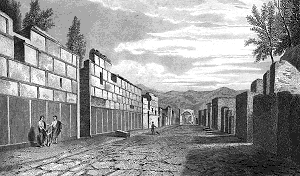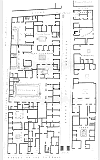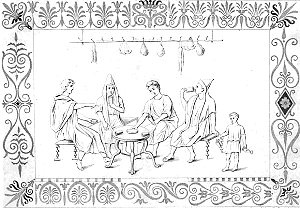Chapter XII - House of the Dioscuri |
|
Having passed up the Via dei Mercurii, beyond the
lupanare and the fountain of Mercury at the
smaller gate of the house of the second fountain, which
is opposite to it, a narrow vicus or alley on
the right separates the line of houses, beginning at
the arch of Caligula, from the most splendid of all the
habitations yet discovered at Pompeii, which has been
named the House of the Dioscuri, or Castor
and Pollux, from two figures representing those
personages on the walls. |
|
The walls of the house of the Dioscuri are, as may be seen in plate LXI, painted below in large red panels, and above represent in plaster a slightly indented rustication. The red panels ought always to be well examined, on the first moment of their excavation, for inscriptions ; as, in one part of this wall, may be found curious Greek alphabets of the imperial times, and, among many other scratched inscriptions, may be distinguished CAMPANI. VICTORIA.VNA. CVM. NVCERINIS, PERISTIS |
and perhaps, with perseverance and the application of a
wet sponge, something more of an historical fast or event
might be recovered.
The plate LXI gives a representation of this street, looking
back from this house of the Dioscuri, under the two triumphal
arches, toward the forum ; and, though the upper story may be
wanting throughout, it must give a tolerable idea of what a
street in Pompeii might have been before the eruption. There
are even certain mouldings which seem to indicate that the
houses were not, in some parts, higher than at present.
|
The plan which is given in plate LX of this part of the street will enable the reader to understand the view. |
|
The house of Ceres, the atrium of which is
given in plate LXII, occupies a very large portion of
the street on the left, and presents to it only a door
and a few very small upper windows. |
PROSALVTEM AVG. CIPARO.
Nearer the door is
M. HOLCON
RISCVM AED OVF.
Also
M CVM MEMOR. ROG
Besides these we find
C. CASELLIVM
AED. DV.F
and in another place
VARIVM
AED OR. RO
We have also
MARCELLVM
AED. ROG
and it is not impossible that, amongst so much bad and very equivocal writing, though in capitals, the three letters under C. Casellium may be intended, by a certain rounding of the D, to be taken either for Duumvir, or Orat ut faveat.
Near the next door is written
V. PONPO. AED. VF.
and, on this account, the house is considered to have been under the protection of the aedile Pomponius, whose name is so ill written. This house has its atrium and four small rooms now visible ; but the remainder was not excavated in March, 1829. Still ascending the street, the following house was protected by Avellius Firmus, and that was succeeded by the thermopolion or lupanare. On the house of Avellius is written
AVELLIVM. FIRMVM
AED. O.V.F. DIGN. EST
CANVSIA CVM. NYMPHIO. ROG
The name of Canusia is very uncertain, but it would seem that he, with Nymphius, might be considered as proprietors of the dwelling.
|
Of the lupanare - for so it appears a house
may fairly be called, which, under pretence of being an
ordinary wine-shop, or thermopolion, in front,
has an inner chamber, painted with every species of
indecency - nothing can be given except the plan, the
waggon, and a drinking-scene which is the subject of
plate LXXX. |
|
Behind the shop, on the right, is a very small
anteroom, in which is painted the waggon of the
Thermopolite, with his horses unharnessed, and his
servants filling his amphorae, given in plate
LXXXI. |
|
The door, on the left, from the shop, leads into the
obscene chamber, which is of small dimensions, and has
a little postern door opening into the vicus of
the house of the Dioscuri. |
|
(1) At a subsequent period, but while this work was in the press, a further excavation was made in the house connected with this lupanare, by which it was discovered that other apartments, ornamented with better taste and more careful execution, existed in the habitation. |






